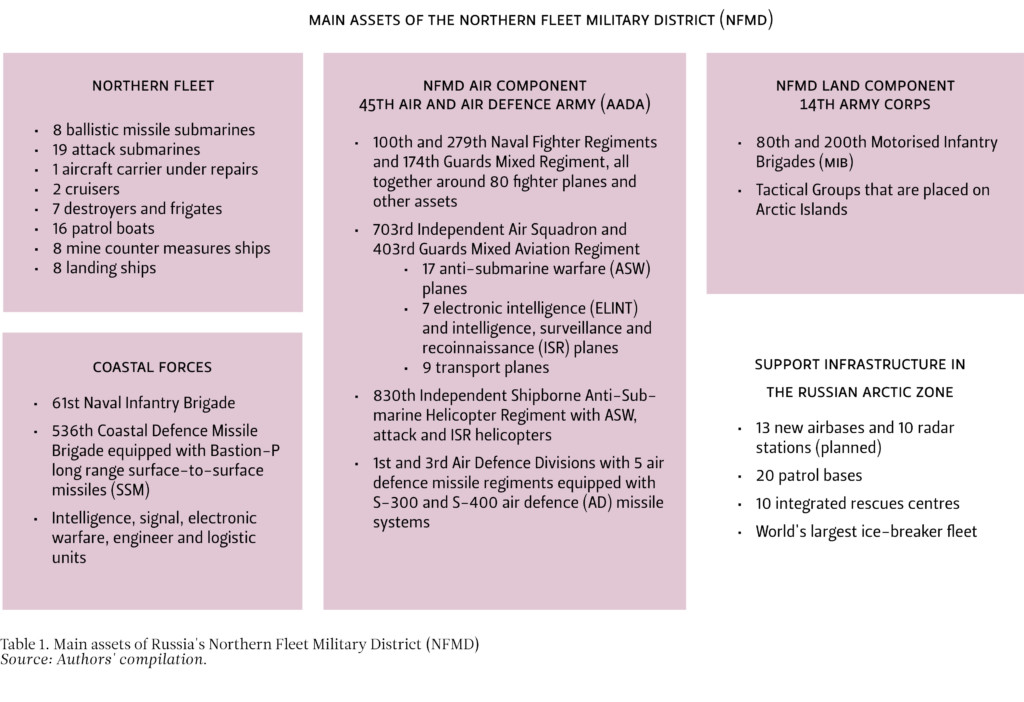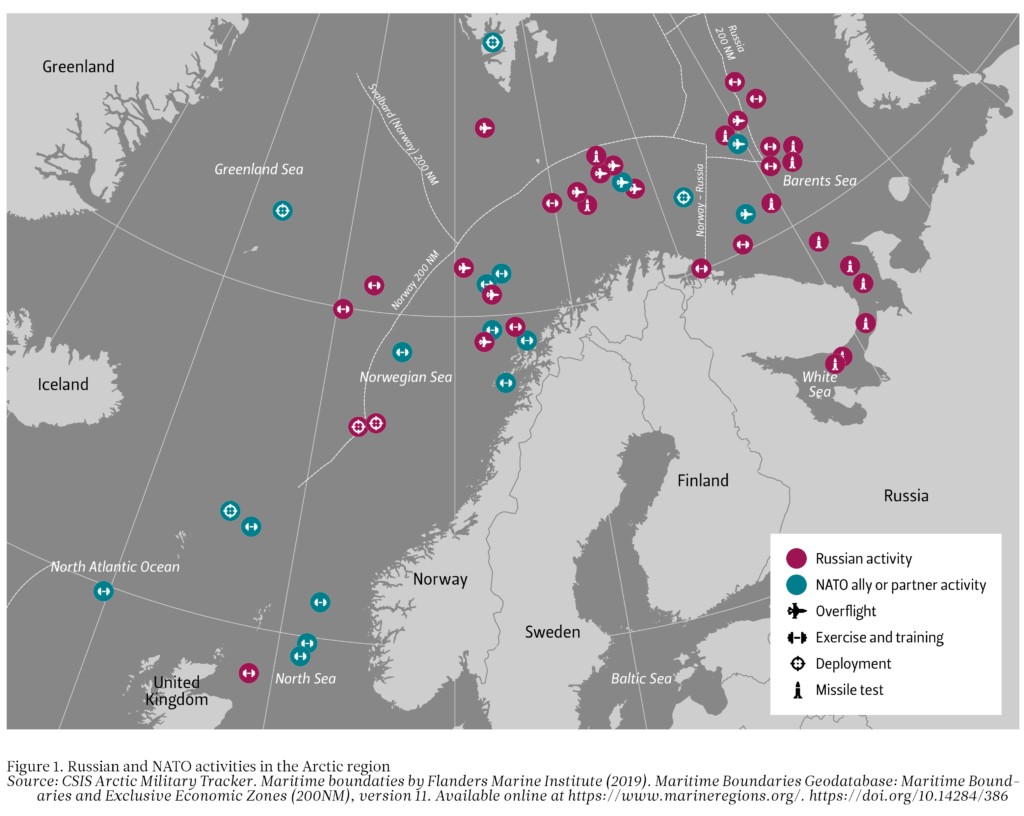yhteenveto
Venäjä on onnistunut rajoittamaan länsimaiden sotilaallista asemaa arktisella alueella käyttämällä hyväksi lännessä vallitsevaa näkemystä arktisesta alueesta poikkeuksellisena rauhan ja vuoropuhelun saarekkeena.
Samanaikaisesti Venäjä on vahvistanut suhteellista etulyöntiasemaansa alueella kehittämällä järjestelmällisesti omia sotilaallisia kyvykkyyksiään. Eskalaatiouhkan muodostaakseen Venäjä on harjoitellut sotilaallisia hyökkäyksiä pohjoisessa sekä kohdistanut hybridioperaatioita arktisen alueen maihin.
Venäjän taloudelliset resurssit Arktiksella ja alueelle sijoitetut sotilastukikohdat ovat keskeisiä maan strategisille tavoitteille sekä kyvylle toimia vihamielisesti. Arktisen yhteistyön tärkeyttä korostamalla länsi on tahattomasti ruokkinut tätä kykyä.
Länsi on yksipuolisesti rajoittanut sotilaallista toimintaansa arktisella alueella lieventääkseen jännitteitä. Lännen arktisen politiikan tulisi jatkossa keskittyä siihen, kuinka se luo kokonaisvaltaisen pelotteen arktiselle alueelle.
Introduction
As a result of Russia’s war of aggression against Ukraine, the West has broadly come to agree that Russia must be deterred in order to stop it from carrying out further acts of aggression. The war has resulted in halting diplomatic cooperation with Russia on many fronts, including the Arctic. However, Arctic policy experts are still engaged in serious discussions on the relevance of continuing limited international cooperation with Russia. This is mainly due to the need for globally important climate and environmental change-related data and research, which become difficult to pursue without Russia’s participation.
This stance of cooperative engagement has its roots in the traditional notion of “Arctic exceptionalism” – an idea stemming from the Cold War era, whereby the region was portrayed as a unique “zone of peace” and a “territory of dialogue” between the West and Russia, despite conflicts elsewhere in the world. Politically, many actors in the West see Arctic cooperation as an avenue for mitigating tensions with Russia, and even as a potential element of common ground to start rebuilding diplomatic relations after the war of aggression has ended. Culturally, there are long path dependencies in cooperative practices, hard-wired research paradigms, belief systems and ideological convictions, as well as broadly shared and uncontested ways to speak about the region, which have generated a sort of “cognitive bias” for many Arctic actors. If one repeats a mantra of “High North, low tension” year after year, eventually it becomes an uncontested truth.
The notion of Arctic exceptionalism is, however, increasingly unwarranted in the current security environment. Its focus is too regional, and it fails to capture how the Arctic is connected to broader geostrategic dynamics in Northern Europe and beyond. It also fails to fully take account of – or deliberately brackets out – the essence of the Russian regime’s zero-sum worldview and confrontational approach towards the West, as well as the role that the Arctic plays in Russia’s broader geostrategic plans for revising the European security architecture. The Arctic cannot be isolated from the current international conflict dynamics as economic and military assets in the region will remain key enablers of Russia’s potential future aggressions and of its ability to achieve its foreign policy goals.
This Briefing Paper analyzes Russia’s actions to maintain its relative power in the Arctic. It argues that Russia has systematically utilized the paradigm of Arctic exceptionalism in its efforts to outmanoeuvre the West in the region. The paper starts by unpacking the current Russian foreign policy worldview of zero-sum confrontation as a general foundation for its Arctic ambitions as well. The paper continues by analyzing Russia’s tactical use of Arctic exceptionalism in its foreign policy endeavours in the region and shows how Russia has steadily increased its military presence in the Arctic with the aim of regional hegemony. The paper examines how Russia has utilized disruptive hybrid methods to weaken other states and to create a sense of an escalating threat. The paper concludes by discussing the unfeasibility of the Arctic exceptionalism paradigm in the region.
Russia as an international actor: Civilizational battle against the West
The full-scale attack against Ukraine made it clear that Russia is a revisionist and expansionist power, which cannot be effectively contained with diplomacy, nor with the mechanisms of the rules-based international order. It also showed that the country is capable of a significant military build-up without general mobilization, and is prepared to take ever-greater risks, commit war crimes, and threaten the West with the use of nuclear weapons to pursue its goals.
The Russian regime portrays the situation as a long-term strategic, cultural, and civilizational struggle with the West. It sees that its own values of conservative authoritarianism are not compatible with the liberal values of the West and that the Western values of democracy, human rights, and the rule of law pose a serious threat not only to the regime’s survival, but also to the ontological essence of Russia’s identity and statehood.
According to Russia’s reading, a power transition phase is underway from a US-led unipolarity to a multipolar world of “multiple value centres” dominated by great powers.[1] Russia sees that the nature of this transition is ultimately a violent zero-sum game based on military power. In its efforts, the country also uses a broader toolkit of state power, including hybrid influencing with the aim of strengthening its own relative position by weakening other states.
For Russia, world politics is not only about great power competition over spheres of influence, but also about great powers having a right to spheres of influence. Moreover, the country sees that the sovereignty of the so-called small border states is always limited and that they must yield to Russia’s “legitimate security concerns”. If necessary, these “legitimate interests” can also be defended on the territory of other states.[2]
By attacking Ukraine, Russia not only aimed to destroy the country and suppress it under Russian dominance, it also made a calculated decision to fully challenge the West and the European security architecture. The regime itself was highly explicit about this, with an aggressive and maximalist list of demands for the West in December 2021.[3] The demands were quickly ruled out as totally unacceptable, but they exposed the magnitude of the revisionist challenge that Russia is willing to pose to Europe. Ten months after the beginning of the invasion, President Vladimir Putin raised the stakes and escalated his confrontational rhetoric even further by stating that Russia is fighting a war against the “collective West”.[4]
The security dynamics in the European north and the potential for cooperation with Russia in the Arctic should be assessed against this background. Russia’s economic and military assets within the region are key to its goals of retaining Putin’s regime and achieving a great power status. Russian activities in the Arctic are first and foremost guided by its ideology and worldview of a zero-sum confrontation with the West. Consequently, the Arctic cannot be approached as an isolated sub-theatre.
Russian foreign policy in the Arctic: The trap of Arctic exceptionalism
Russian stance towards the Arctic has historically been neither linear nor static and it has had elements of both cooperation and confrontation. During the current regime, Russia has aimed to utilize regional multilateral structures and to generate economic cooperation with both Arctic and non-Arctic countries. This, however, has been coupled with more aggressive military activities, as well as a heightened emphasis on national security issues.
The key strategic goal for Russia’s current regime is to maintain a relative military advantage in the Arctic and limit NATO’s and Western military development in the region. The Arctic exceptionalism paradigm has provided excellent openings for this.[5] The Kremlin has tried to direct interaction towards Arctic multilateral cooperation in particular, so that instead of enhancing deterrence in the region, the Western Arctic countries would concentrate their attention on environmental and climate-related cooperation – a vital policy field especially for the Western Arctic countries.
Bilaterally, Russia has successfully exploited the Western tendency to engage in diplomatic efforts and in confidence-building and risk-mitigation measures. It has been able to rely on the willingness of smaller European Arctic countries to “self-deter” as part of their efforts to maintain good bilateral relations, cooperation and risk mitigation. For Norway, this self-deterrence was made clear by the practice of self-imposed restraints on military activities near the Kola region. Finland has also downplayed threat perceptions in the Arctic and promoted political and economic cooperation with Russia in its efforts to manage bilateral relations.
In many ways, Russian efforts to cultivate Arctic exceptionalism have been effective. First, the widely endorsed notion of “High North, low tension” and the Western hopes to build multilateral cooperative security have helped to keep NATO out of the region. Second, it has steered the West to underinvest in Arctic military capabilities and neglect regional deterrence, simultaneously enabling Russia to strengthen its relative position in the region. Third, it has helped to gain access to and utilize international research projects that improve infrastructure and living conditions in the North, thereby facilitating energy projects and military infrastructure in the region as well. And fourth, it has constructed an impression of the region as a stable investment area which attracts foreign capital for Arctic mega-projects, which in turn helps Russia to maintain its status as an energy superpower and utilize energy as a weapon against the West.
The aim of the cooperation has arguably been to direct Western attention and activities, as well as to hide Russia’s own active and systematic steps in efforts to maintain regional hegemony. According to recent news reports, Norway and Russia are “in a constructive process” on the transfer of the Arctic Council chairmanship from Russia to Norway, even though none of the Western foreign ministers will travel to Russia to the traditional ministerial meeting.[6] The fact that Russia seems to accept this does not indicate that the country would be interested in cooperation in good faith, but highlights that Russia has major strategic interests in keeping the Western focus closely on multilateralism.
Russian military activities in the Arctic: Active steps behind the exceptionalism smokescreen
Russia is the strongest military actor within the Arctic region, and the country considers it crucial to maintain its relative superiority, as well as its capability for strategic initiative and escalation dominance in the region. The Kola Peninsula is Russia’s gateway both to the Arctic Ocean and the Atlantic, and the area’s infrastructure offers the best possibilities for force projection to the Arctic and beyond.
Russia tries to portray its own military buildup as defensive, points the finger at increased military activities by other nations when it comes to justifying its own military activities, and condemns all Western military presence in the region as “destabilizing”. Russia has argued that an increased Western presence could lead to militarization of the region, with all the possible effects of increasing tensions and spillover risks.
As recently as 2021, President Putin claimed that Western concerns about Russia militarizing the Arctic were “completely groundless”.[7] In reality, Russia has been systematically developing its military capabilities in the region for the last 15 years (see Table 1).

In addition to Russia’s conventional capabilities, its nuclear assets located in the Arctic play a key role in its efforts to maintain its great power status. They also function as the main tool for coercive actions against other countries. The principal patrol and launch area for Russian ballistic missile submarines is in the Arctic Ocean, and Russia’s long-range aviation strategic bombers use air bases in the Arctic. The significance of nuclear weapons is increasing in the current situation, where conventional Russian military capabilities have been suffering major losses in Ukraine.
The protection and use of these strategic assets is the task of Russia’s Northern Fleet. To underline the importance of the Arctic in Russian military thinking, the role of the Fleet was further emphasized in 2021, when the Northern Fleet Military District (NFMD) was formed. In a possible military conflict with NATO, the NFMD’s main task is to secure control of the Barents Sea, deny Western forces’ operations in the Greenland Sea, Norwegian Sea, North Sea and Northern Atlantic, and to protect the ballistic missile submarines by forming a Bastion defence that prevents Western naval and naval aviation from attacking Murmansk and the Kola Peninsula. This is implemented by pushing the Northern Fleet’s attack submarines and surface combat groups towards the Greenland-Iceland-UK (GIUK) Gap to gather intelligence and to intercept ships bringing reinforcements from North America to Europe.
The 14th Army Corps with its three brigades would defend the Arctic Islands and the Murmansk area. With reinforcements, the Corps would aim to push the defences West, to Northern Norway and Northern Finland. If possible, the Corps would probably try to continue the offensive along Norway’s northern coast towards Bardufoss. This kind of scenario resembles old Soviet offensive plans, and it was rehearsed, for example, in the Zapad 2017 strategic exercise.
In a military conflict, Russia would reinforce its forces on the Kola Peninsula with air and land force units, airborne forces and long-range surface-to-surface missile (SSM) units. This has also been rehearsed during strategic exercises. Russian airborne forces have likewise practised parachute landings over Franz Josef Land, followed by reinforcement by sea. Since the distance from the Kola Peninsula to Franz Josef Land is almost the same as to Svalbard, it can be concluded that Russia is preparing to occupy Svalbard in times of crisis. That would reinforce the NFMD´s defences and offer a base for long-range SSM and air defence units.
Russia is also conducting show-of-force activities with its nuclear weapon forces. During the nuclear forces’ annual Grom exercises, Russia normally fires ballistic missiles from SSBNs close to the Kola Peninsula to a target area in the Far East. The Grom exercises also include long-range aviation strategic bombers that conduct simulated attacks in the region. In 2021, these activities included exercises where three SSBNs simultaneously broke through the polar ice to simulate missile launches. Russia is also using the White Sea region for testing its new nuclear weapon carriers like Bulava submarine-launched intercontinental ballistic missiles and Poseidon nuclear torpedoes.
Operationally, Russia has adopted an aggressive posture in the Arctic. The Northern Fleet’s submarines regularly practise breaking through the GIUK Gap to the Atlantic. Russia’s long-range aviation and Northern Fleet conduct long patrol flights and sailings close to other Arctic nations’ areas. These activities are increased particularly during NATO exercises close to the region. Since 2016, the activities have expanded, become more frequent, and have included live-fire exercises, simulated attacks, and snap readiness exercises near the Norwegian borders. Although in many cases the activities may lack wartime relevance, they have been effective power demonstrations in Russia’s efforts to intimidate and generate concerns in the West about escalation.
A majority of Western commentators have seen Russia’s military development in the Arctic as purely defensive and as natural behaviour by a state to secure its increasingly exposed borders in the north and the economic assets therein. However, Russian military capabilities in the Arctic cannot be considered purely defensive as they are designed for offensive operations against Russia’s Arctic neighbours.
Despite this aggressive posture, the West has largely neglected its deterrence efforts in the Arctic and sought to limit military activity in the north for general escalation-management purposes. For instance, Western military exercises have taken place in the Norwegian Sea, the Greenland Sea, and the North Sea, but not in the Barents Sea. Russian exercises, on the other hand, have taken place not only in the Barents Sea, but also in the Norwegian Sea and the North Sea (see figure 2).[8] This indicates not only that Russia is ready to take more provocative steps, but also that Russia has to a large extent succeeded in drawing the red lines in the sea domain of the European Arctic.

Both NATO and the United States started to increase their exercises and patrolling in the Arctic as a result of Russia’s increasingly aggressive military posture only a few years after Russia invaded Crimea. But even after that, the Western states did not increase their permanent military presence in the Arctic, nor did NATO explicate its position in the region. Generally, it can be estimated that Western armed forces are militarily about 10 years behind Russia in the Arctic. Even with the losses that the 200th Motorized Rifle Brigade and the 80th Arctic Motor Rifle Brigade have sustained in Ukraine, the naval component of the Northern Fleet and the strategic bombers remain intact.
Russian hybrid activities in the Arctic: Increasing the sense of threat
Besides military means, Russia also uses aggressive and disruptive non-military operations against its neighbouring states in the region. Prior to the war of aggression, many Russian hybrid operations were often subtle. Recently, a number of these activities have also been investigated in the public media, including for instance cyber operations, spreading false news and propaganda, building interdependencies by controlling the operation of critical infrastructure such as gas pipelines and a nuclear power plant, and providing financial incentives for influential economic and political actors.
Since 2015, Russia has more actively applied coercive hybrid actions against Western Arctic states. It has generated and exploited migrant flows, as was seen in 2015 at the northern section of the Finnish-Russian and Norwegian-Russian borders. This demonstrated the effectiveness of the Russian strategy of persuading individual states to seek accommodation with Russia bilaterally.
Russia has arguably also targeted key infrastructure in the European North. Two undersea fibre-optic cables which provided a vital internet connection and communications links between mainland Norway and the Svalbard archipelago in the Arctic Ocean were put out of action in November 2021 and January 2022. Russia has also purchased or tried to purchase property near strategic targets, especially in proximity to air-surveillance and radar stations, and ammunition storage facilities. Another clear line of interest is related to critical civilian functions, as some purchases are situated near the main electrical grid, railway connections and telecommunications networks. Moreover, Russia has actively used GPS jamming against Nordic countries, posing a clear danger to civilian aviation. Again, these activities underline that the Arctic is no exception for Russia.
Conclusions: The end of exceptionalism in the European Arctic
Russia has been actively developing its military and hybrid capabilities against the West partly under the cover of Arctic exceptionalism. Western countries have prioritized cooperation with Russia in the Arctic instead of military competition, in order to minimize tensions and conduct important environmental cooperation. Unfortunately, the notion of “High North, low tension” is no longer valid. Since President Putin himself has declared the collective West a strategic enemy, this means that Russia is increasingly far away from being a normal stakeholder in Arctic and European security.
Some level of communicative engagement with Russia is necessary to handle technical-level connections, as well as to avoid misunderstandings, miscalculations and mutually unwanted events, for instance in the context of military exercises or border control. Cooperation in good faith or possibilities for some sort of détente are largely out of the question. The Russian challenge is systemic and long-term in nature. This is because the determining factor continues to be the Russian understanding of world politics as a constant struggle between great powers, its ontological and deep-rooted antipathy towards the West, and its strategic culture of militarism and violent imperialism.
It is crucial to note that Arctic economic and military resources continue to play an essential role in Russia’s quest to achieve its grand strategic goals, and in its ability to conduct aggression. The West has unintentionally facilitated this capacity through regional cooperative practices. However, as Arctic cooperation has halted, Russia is increasingly lacking this “multilateral carrot” to steer Western activities in the region.
Given the level of the revisionist threat that Russia is posing to European security, it would be unwise to cooperatively engage with Russia in the north and help to facilitate its capabilities for disruption. The Western Arctic stance must match the current realities and the focus should be on building comprehensive deterrence in the northernmost regions of Europe as well.
Endnotes
[1] Sherr, James and Igor Gretskiy (2023) “Why Russia went to war: A three-dimensional perspective”, ICDS Analysis, International Centre for Defence and Security. https://icds.ee/wp-content/uploads/dlm_uploads/2023/01/ICDS_Analysis_Why-Russia_Went_to_War_James_Sherr_Igor_Gretskiy_January_2023_EDIT.pdf.
[2] Lavikainen, Jyri; Pynnöniemi, Katri; Saari, Sinikukka; Helin, Outi and Mäkinen, Sirke (2022) “Pohjois-Eurooppa Venäjän ulko- ja turvallisuuspolitiikassa”, Publications of the Government´s analysis, assessment and research activities 2022: 38, Prime Minister’s Office of Finland. https://www.fiia.fi/wp-content/uploads/2022/04/pohjois-eurooppa-venajan-ulko-ja-turvallisuuspolitiikassa.pdf.
[3] The Guardian (2021) “Russia issues list of demands it says must be met to lower tensions in Europe”, 17 Dec 2021, https://www.theguardian.com/world/2021/dec/17/russia-issues-list-demands-tensions-europe-ukraine-nato
[4] TASS (2022) “Collective West unleashed war in Ukraine, culprit of current events — Putin”, 8 July 2022, https://tass.com/politics/1477149.
[5] See Conley, Heather A. and Colin Wall (2021) “Hybrid threats in the Arctic: Scenarios and policy options in a vulnerable region”, Hybrid CoE Strategic Analysis / 28, The European Centre of Excellence for Countering Hybrid Threats. https://www.hybridcoe.fi/wp-content/uploads/2021/08/20210826_Hybrid_CoE_Strategic_Analysis_28_Hybrid_Threats_in_the_Arctic_WEB.pdf.
[6] Nilsen, Thomas (2023) “Foreign Minister Huitfeldt outlines plan to bring Arctic Council back from a year in limbo”, The Barents Observer, 23 March 2023. https://thebarentsobserver.com/en/arctic/2023/03/foreign-minister-huitfeldt-outlines-plan-bring-arctic-council-back-limbo.
[7] Bye, Hilde-Gunn (2021) “Plenty of Ground for Cooperation in the Arctic, Putin Says”, High North News, June 17, 2021. https://www.highnorthnews.com/en/plenty-ground-cooperation-arctic-putin-says
[8] CSIS (n.d.) “Arctic Military Activity Tracker”, Center for Strategic and International Studies. https://arcticmilitarytracker.csis.org/#57



